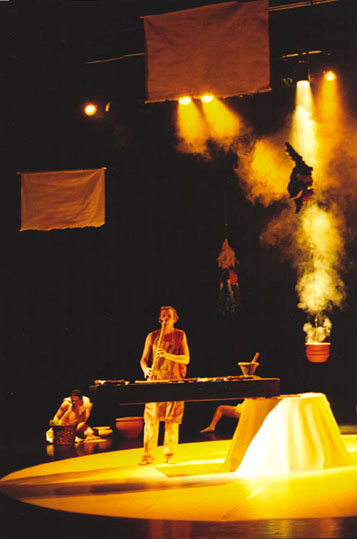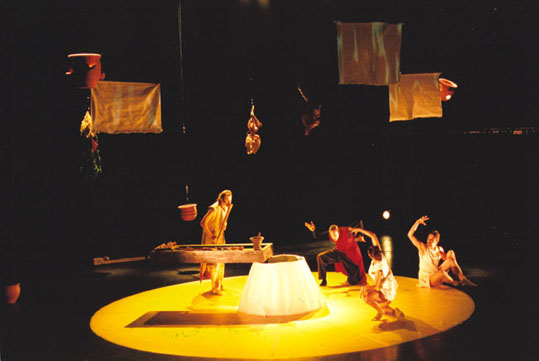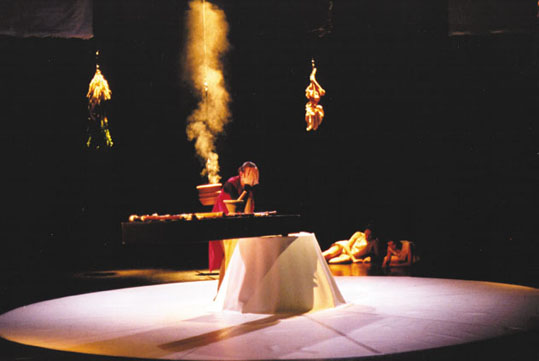Main Menu
CD releases

VisiSonor webshop
Visit the VisiSonor webshop for the latest CD releases and more!
Mensa Secunda
 |
Mensa Secunda is a circular story of obsession and transformation.
Four characters –Apicius, The Hired Chef and the slaves-, music, dance, space and video develop the plot.
The story follows the obsession of a chef, the musician character, and its desperate search for the perfect recipe.
As we enter the stage, the smell of copal, incense used in sacrificial rituals envelopes us.
A table with a corpse on it, and attached to an inverted cone in the centre, is design to turn as time passes and by the end of the spectacle, a complete circle has been achieved. |
Mensa Secunda captures de audience visually and psychologically by its sensuousness. As we enter the stage, the smell of copal, tree-resin incense used in sacrificial rituals envelopes us. The sound of drops of water merges with the scent of copal to create a space in waiting. It is a space that has been moving before and is about to move again. A table with a corpse on it, and attached to an inverted cone in the centre, is design to turn as time passes and by the end of the spectacle, a complete circle has been achieved. Three pots, herbs, bread and three screens hang from the ceiling giving the space a special texture. The objects are hung within the range of a central white circle on the floor. This is the kitchen. At the back of it, an apron is also hanging, waiting to begin the feast again.
Mensa Secunda is a circular story of obsession and transformation. Four characters, music, dance, space and video develop the plot. The story follows the obsession of a chef, the musician character, and its desperate search for the perfect recipe. One of the dancers plays a hired chef, who stalks Apicius, the musician chef. There are two slaves to serve Apicius, but their intentions become clear as the piece evolves when they help the hired chef to steal the recipe from Apicius. Once the recipe is stolen, a transformation occurs. The slaves take Apicius away and the stalking chef becomes Apicius, to begin the story again. The table turns an octave of a circle with each scene to complete a full circle, depicting a day.
The musician character is likened to that of a chef, playing whit his ingredients and driven crazy by desire. He tastes herbs and obsessively repeats a recipe in Latin as a depiction of his obsession in finding the perfect recipe. Sometimes the words he recites are barely audible and become a musical texture merging the rest of the sound scope. The musician combines his instrument playing with a concealed manipulation of electronic tools inside the table –a fact that due to the design of the stage is invisible. The music was composed following the dramaturgy. It uses two main instruments: recorder and sounds. The recorded sounds of these two instruments are digitally transformed two create a vast scope of sounds and textures. The music was built in three layers: tape music is the basis and times the whole piece, live blokflute playing explores all the range and textual possibilities of the instrument with remarkable ease, and live-electronic sound sample are triggered by a dancer –the Hired chef.
The voice of the chef and the sounds produced live by the slaves chopping and chewing vegetables, as well as pouring shells in a pot are combined with pre-recorded sounds of pots falling, knives and water boiling. This complex soundscape evokes a dark world of desire, obsession and the search for the perfect recipe.
The dancers’ movements evoke an organic, animal way of being. The two slaves characters creep across the stage and are as much actors as dancers. All the elements of the piece: stage design, electronics, music and dance are woven together to create a living and evolving spectacle.

CONCEPT
A calm space receives the audience. As they walk in, hanging birds‚ figures in a half-shadow environment are dripping on a body of water. Behind it, at the middle of the space, there is a table, the Mensa. A profound blue-misty atmosphere, a deep-layered sound with the constant drops of water, and the smell of myrrh and incense rounds off a space ready for a ritual. The environment engages the spectators‚ senses, introducing the ritual. From this point on the stage will follow the characters‚ development; will unfold with them.
After the music and the space had made the first statement, two slaves enter the space carrying a bulky item. It could be a corpse; it could be a dish ready to be served on the table. The characters deposit the bulky item on the table: "the table is laid". They wash their hands, ready to eat, ridding themselves from their deeds. After a short blackout the story begins (again). Along the piece all the characters have particular relationships between each other. Apicius and The Magirus story will depict the roles reversion. The Magirus will have the ability to influence Apicius music and have voice of his own making use the sensors system and live electronics in key moments during the piece, providing the spectator with connections and sound-movement images that will enhance the roles reversion. At the middle of the Scene Mensa Secunda, The Magirus takes over Apicius‚ place. The slaves take out of the stage a completely delirious Apicius. The Magirus starts again the story, overlapping with the first one presented. The slaves are kept in a vicious circle‚, in which they always plot against the current Apicius and serve the current Magirus. Despite the circular nature of the piece, it constantly surprises the spectator with new points of view, with a highly evocative, sometimes energetic and tense performed along with a rich and colourful music.
Everything happens within a day, the table is rotated on one end, depicting a clock. The dynamic space has no front and no sides, only the concept of Underworld (floor), the World (the middle/mensa) and the Heaven (ceiling, hanging birds and objects in the kitchen). The audience have the sensation of moving around the setting, as the piece develops, they watch the events from different perspectives.
Mensa Secunda uses the context of the Roman meal to depict the transformation of a desire into an obsession. Features from the Roman etiquette and imagery are mixed and taken to build a timeless setting. Magical atmospheres, metaphors of human obsessions, archetypes and symbols merge to create conscious and subconscious meanings, like in a dream. A recipe becomes a spell; a desire transforms into an obsession, a table that is also an altar the cook becomes the food. Elements reverse. The obsession travels from character to character in a circular story.
DRAMATURGY
A group of recipes by the famous Roman cook, Marco Gavio Apicius (b. ca. 25 B.C?), inspired the story and provided the scenario for Mensa Secunda. The subject of the actions implied in these recipes –the cooked animal- has been substituted for the Chef, providing the story with the scenery to present different aspects of totemism. The cook worships his dishes and becomes his own dish. Then, a reflection of Apicius savours Apicius. This is a metaphor of the Deities worshipped through the ritual slaughter of animals identified with a particular Deity. The Gods became their own food. This broken taboo is presented as an archetypal image when Apicius feeds the foreign eyes with his own flesh and blood. Bacchus, the Bacchanalia and the Dyonisic behaviour are presented in Apicius’ trance and the characters related to him. Apicius’ constant transformation depicts any man’s delirium obsessed with and chained up to a passion. These are the other archetypes part of the concept.
The sequence of events, systems of symbols and archetypes are framed within the concept of a circular time. Simultaneous and sequenced sounds, images, and odours will guide the spectator in a trip into Apicius’ delirious dreams. The several layers in which the spectacle interweaves actions, give the spectator the possibility to follow different stories. Cycles of transformations are completed all along the piece. The parallel time lines weave a tapestry of aural, visual and olfactoral events; a succession of scenes where the last one can be first.
The actions implied in the historical recipes by Marco Gavio Apicius are the first guidelines for the dramaturgy. A recipe is a story in itself; the ritual of being fed, the cycle of life. The recipes are used as a frame to make the analogy to Apicius’ transfiguration process. They symbolise the series of transformations derived from a certain obsession, the unexpected changes of roles, the games of the fate. A number of passions, emotions and meanings are drawn from these actions.
"Remove the skin and make diagonal incisions into the meat [… ] ensure that the head is not in the water [… ] leave only the meat and the bones"
An event resembling the action of cutting the character’s skin is powerful in itself. This action takes place in the context of Apicius’ delirium and establish a series of relations with the several faces of his delirious dream: the Foreign eyes, the dialogue with the ingredients, the slaves entertaining his guests at his feasts.
"… leave only the meat and the bones" What has been taken when only the bones and the meat have been left? Why have it been taken? From whom has it been taken? Who took it? From the relationship between characters and elements in the scenes we draw the meanings, the archetypes and the symbols that convey the essence of our concept.
The dramaturgy’s second source of actions and primary source of characters are taken from historical records found in "Il Satyricon" by Petronio. (ca. 62 A.D.) The habits before, during and after the meal, the table etiquette, the diverse functions of the slaves, the guests, the social role of the dinners, among a vast amount of other images give us a enormously rich source of images subject to be presented as symbols and provide elements to round off the aesthetic of the performance.
|
Concept: Jorge Isaac
Music: Roderik de Man
Blockflute & Live Electronics: Jorge Isaac
Choreography: Benjamin Petitjean
Dance: "Morphodidius" (Benjamin Petitjean, Isabel Ariel, Nicolas D. Legrand)
Video: Marcel Wierckx
Stage Design: Nikolaas Vande Keere (UR architects)
Dramaturgy & Stage Direction: M.Silva
Ligth Design: Alex Brok & Vincent van Roon
Costumes: Nicolas Delamotte Legrand
Production: Visisonor Media Productions (2004)
With the support of:
Fonds voor de Amateurkunst en Podiumkunsten
VSB Fonds
Fonds voor de Scheppende Toonkunst
GAUDEAMUS Foundation
STEIM
